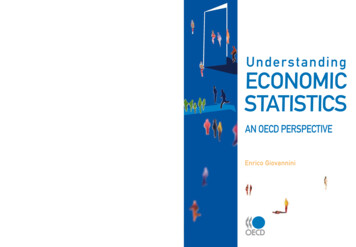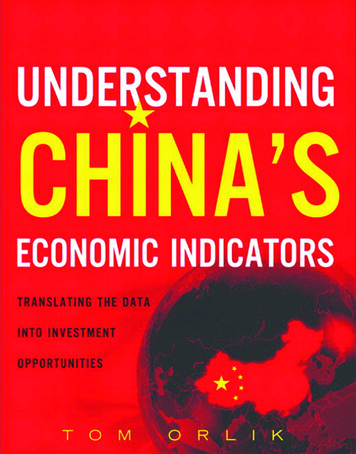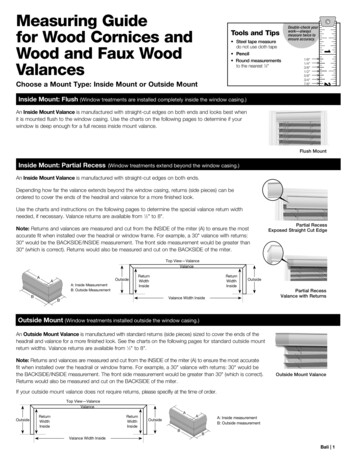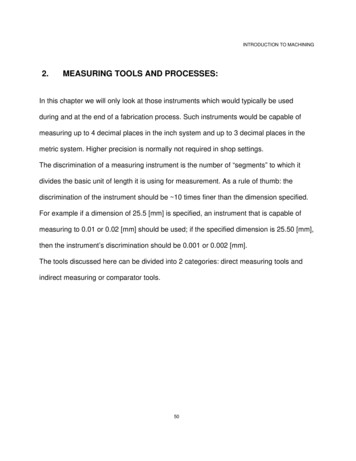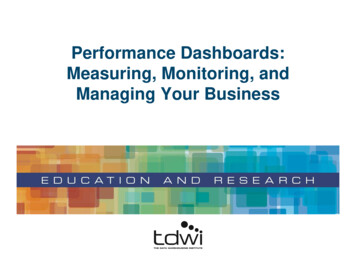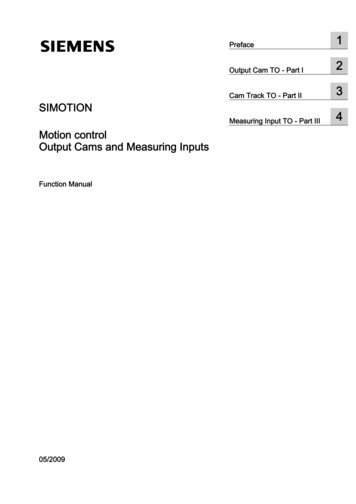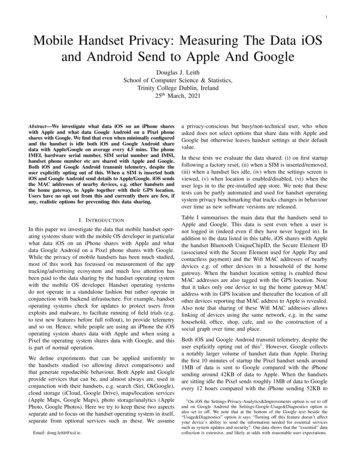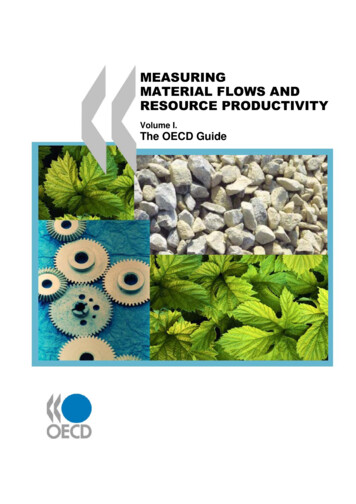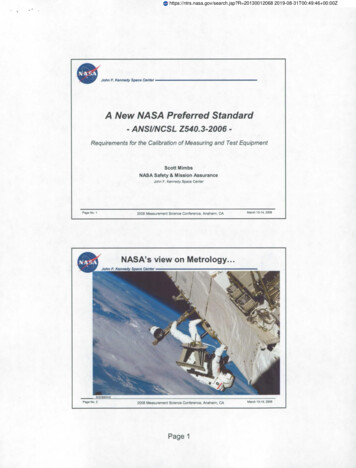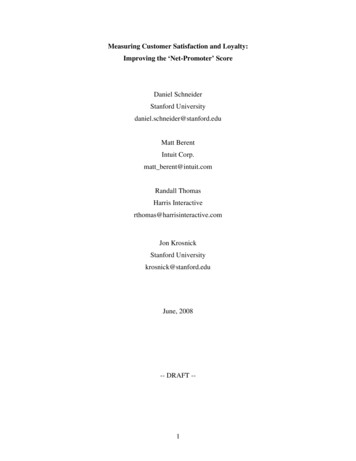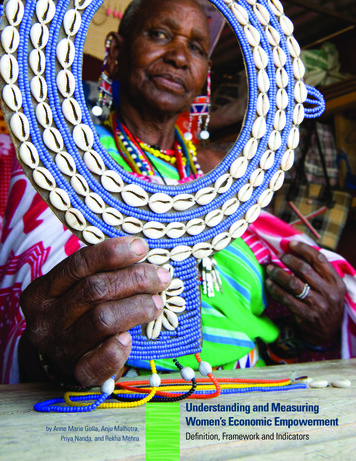
Transcription
Definition, Framework and Indicatorsby Anne Marie Golla, Anju Malhotra,Priya Nanda, and Rekha MehraUnderstanding and MeasuringWomen’s Economic EmpowermentDefinition, Framework and Indicators
2 Understanding and Measuring Women’s Economic EmpowermentAnne Marie Golla/ICRWAcknowledgmentsICRW gratefully acknowledges theDepartment of International Development(DFID), the ExxonMobil Foundation and theBill and Melinda Gates Foundation for theirgenerous support of this work.Cover photos: David Snyder/ICRWDesign: Barbieri and Green 2011 International Center for Research on Women (ICRW). Portions of this document may be reproducedwithout express permission from but with acknowledgment to ICRW.
Definition, Framework and IndicatorsI. IntroductionThere is increasing recognition that economically empowering women is essentialboth to realize women’s rights and toachieve broader development goals such aseconomic growth, poverty reduction, health,education and welfare. In the last five years,a broad range of organizations have committed themselves to the goal of women’seconomic empowerment. These organizations realize that economically empoweringwomen is a win-win that can benefit notonly women, but society more broadly. Itpromotes women’s ability to achieve theirrights and well-being while also reducinghousehold poverty, increasing economicgrowth and productivity, and increasingefficiency.Research has found strong reasons to emphasize women’s economic empowerment indevelopment programs: Economic empowerment is one of themost powerful routes for women toachieve their potential and advance theirrights. Since women make up the majority of theworld’s poor, meeting poverty-reductiongoals requires addressing women andtheir economic empowerment. Discrimination against women is economically inefficient. National economies lose outwhen a substantial part of the populationcannot compete equitably or realize its fullpotential. Working with women makes good business sense. When women have the rightskills and opportunities, they can helpbusinesses and markets grow. Women who are economically empoweredcontribute more to their families, societiesand national economies. It has beenshown that women invest extra income intheir children, providing a route to sustainable development.As interest in fostering women’s economicempowerment grows, two questions arise.1. How is women’s economic empowermentdefined? What does the term women’seconomic empowerment encompass?2. How can women’s economic empowerment be measured and evaluated soorganizations can show they are on theright track to achieving it?Answers to these questions are essential todesign meaningful strategies that will leadto women’s economic empowerment. Thisdocument addresses them by presenting:1. A definition of women’s economic empowerment;2. A measurement framework that canguide the design, implementation andevaluation of programs to economicallyempower women; and3. A set of illustrative indicators that canserve as concrete examples for developingmeaningful metrics for success.3The concepts presented here are meant tohelp practitioners, researchers and donorsdesign effective, measurable interventions toadvance women economically. In developing these concepts, we have drawn both onthe available literature and on ICRW’s directexperience in evaluating women’s economicempowerment programs. This document is intended as a conceptual guide, rather than anoperational tool kit. Economic empowermentis a complex process, and the general framework presented here will have to be adaptedto meet the needs of specific projects.Brian Heilman/ICRW
4 Understanding and Measuring Women’s Economic EmpowermentII. Defining Women’s EconomicEmpowermentIII. Addressing Women’sEconomic EmpowermentDefinition: A woman is economicallyempowered when she has both the abilityto succeed and advance economicallyand the power to make and act oneconomic decisions. To succeed and advance economically,women need the skills and resources tocompete in markets, as well as fair andequal access to economic institutions. To have the power and agency tobenefit from economic activities, womenneed to have the ability to make andact on decisions and control resourcesand profits.To achieve women’s economic empowerment, organizations must address theunderlying factors that contribute to it:individual and community resources, andnorms and institutions.E ME NTER A N D A GENCYar e r e s o u r c ed shsnalma k e cho i c dnoaresnti neco d e f ICADWPOWOMEN’SECONOMICEMPOWERMENTVANCAs Figure 1 illustrates, economic empowerment is comprised of two inter-relatedcomponents: 1) economic advancement and2) power and agency. Both componentsare connected, and both are necessary toachieve better lives for women and theirfamilies. Economic gain and success(economic advancement) promote women’spower and agency. At the same time,when a woman is able to control and sharein resource use (power) and to define andmake choices (agency), she is better able toadvance economically.Resources are the building blocks womencan draw on to succeed economically orto exercise power and agency. Resourcescan be at the individual or community level.They are more than financial or monetary innature, and include: Human capital (e.g., education,skills, training) Financial capital (e.g., loans, savings) Social capital (e.g., networks, mentors) Physical capital (e.g., land, machinery)Norms and Institutions are the “rules ofthe game” or the organizational and socialsystems that govern activities and mediate relations between individuals and theirsocial and economic environment. Normsand institutions influence how resources aredistributed and used. Norms include gender defined roles,taboos, prohibitions and expectationssuch as whether or not it is appropriatefor women to be in public spaces, holdcertain types of jobs, or manage money. Institutions include legal and policystructures, economic systems, marketstructures, marriage, inheritance andeducation systems.NOno m ic su cc e s sOe cono c g ai n E Cmi ec oMAnne Marie Golla/ICRWFigure 1: Women’s Economic Empowerment: Two Necessary, Inter-related Components
Definition, Framework and Indicators5REProjects may approach economic empowIn addition, economic empowerment can beerment by working either to enhance theaddressed at different levels. For example,resources available to women or to redefineprojects may work at the individual, housenorms and institutions. Furthermore, projectshold or organization level, or at the level ofmay work toward advancing women economi- communities or social networks.cally or building women’s power and agency.The specific factors that signal progressThese different paths to addressing women’s economic empowerment110613 ICRW Folder graphics B G Y:11-0 10/5/11 12:09 PM Page2Figure 2. For example, a microcredit programmay be different in different contexts. Theythat provides loans to women works primarily may even change over time, as countriesto increase women’s economic advanceor regions become more developed. Figurement through resources. A literacy or life2 provides examples of how some projectsskills program primarily increases women’swould fit within the framework.personal resources in order to increase theirpower and agency. While both projects work No single program can address all of theto increase women’s economic empowerfactors that contribute to women’s economicment, they do so along different pathways.empowerment. Rather, if economic empow-PROJECT EXAMPLELiteracy Trainingprovides a personalresource that boostswomen’s agency.CESRUSOP OWEREven though most programs take on theirspecific slice of the pie, framing their workwithin a broader framework of economic empowerment is essential. Understanding thewider opportunities and challenges womenface in the specific context of the project isimportant in order to: Determine where resources are best spentto meet goals; Design the best intervention; Identify areas outside of the project focusthat may help or hinder its success; and Define clearly what the program willand will not change, and where changeoutside of the project is necessary for theproject to succeed.ANPROJECT EXAMPLECommunity Campaignschange social institutions(norms) that present barriersto women’s agency.DAGENCYWOMEN’SECONOMICEMPOWERMENTE C O NOMIPROJECT EXAMPLEMarket Based Approacheschange how market actorsand institutions treatwomen and allow for theireconomic advancement.ANCE MTUTIOADVNSCPROJECT EXAMPLEMicrocreditremoves constraints tofinancial resources thatmay allow women toadvance economically.erment is seen as a complex, multilayeredpie, programs should “choose their slice.”That is to say, they should concentrateefforts on where they can make the mostdifference given their resources, timeframe,local conditions, and also consider whatother organizations are doing.ENTNORMS ANDTISINFigure 2: Contributors to Women’s Economic Empowerment Addressing Resources, Institutions and Norms
6 Understanding and Measuring Women’s Economic EmpowermentIV. Measuring Women’sEconomic Empowermentpower and agency, many projects do not seekto achieve change in both areas. This meansthat individual projects may focus measurement more on one component than the otherAs illustrated in Figure 2, women’s economic110613 ICRW Folder graphics B G Y:11-0 10/7/11 9:06 AM Page 3or may not measure both components.empowerment has many dimensions and isspecific to the context under consideration.Projects address economic empowermentthrough different pathways. The indicatorssuitable for one area or program may notbe relevant elsewhere. No universal set ofindictors is appropriate for every project, inevery sector and in every context.Rather, measurement should align with the“slice” of women’s economic empowerment that a particular program choosesto address. For evaluation purposes, aproject should measure only what itwill reasonably change. While effectivelymeasuring women’s economic empowermentrequires considering indicators of both women’s economic advancement and women’sFigure 3 presents a matrix for measuringwomen’s economic empowerment, whichuses sample indicators to show differentstages at which results can be measured.These stages range from project outputsand immediate outcomes to intermediateand longer term impacts. Determiningwhich stage to measure depends on whatis feasible to measure given the project’sresources, expected impact and timeframe.As the matrix shows, agency/power andeconomic advancement can be measuredseparately. Both quantitative and qualitativemethods are appropriate for measurement,depending on what type of information isneeded and feasible to collect.P OW E R A N D AG EN tion inactivitiesIncreased selfefficacy, abilityto rol Women'sparticipation inactivitiesNew skills,changes inbusinesspracticeAccess to UTCOMEOUTCOMEIMPACTIMPACTEC O N OMIC A DVA NCEM EN TFigure 3: A Framework to Measure Women’s Economic EmpowermentThe framework emphasizes the importanceof not focusing exclusively on impact indicators in developing monitoring and evaluation(M&E) plans. It is equally important to prioritize the measurement of process, output andoutcome indicators, such as women’s participation in the project and which womenparticipated. All projects should measurebasic process outputs and outcomes.These indicators can provide initial assessments of whether a project is on the righttrack and whether it is engaging women asintended. They are usually more straightforward to measure than indicators of deeperor longer-term impact. Not all indicators canor should be measured at the highest level.Often, it is not realistic to expect to beable to measure the deepest, long-termimpact within the project’s time frame.
Definition, Framework and IndicatorsV. Illustrative IndicatorsWomen’s economic empowerment is amultifaceted concept. Given how projectand context-specific its measurement mustbe, it is not possible to define a universalset of indicators suitable for every project.However, we can provide an illustrative setof indicators in three key areas emphasizedin the framework depicted in Figure 3:7Our experience shows that most interventions are trying to achieve success onthese measures at either the individual andhousehold level, or at the community andinstitutional level. Therefore, we provideillustrative indicators for both these levels.1. Reach and Process Indicators2. Economic Advancement Indicators3. Agency or Power IndicatorsJeannie Bunton/ICRWReach and Process IndicatorsIndicator/QuestionParticipationNumber of women and men who participated in different activitiesWhat barriers kept women from participating?How were participants selected?Did the selection process itself exclude any kinds of women (or other kinds of groups)?Number of those selected who did/did not participate.Number of women who started activities and then dropped out. What are the reasons given for dropping out?Which women are participating and which aren’t?Issues facedby womenHow did the community respond to the activities? To women’s participation?SuccessCould women effectively implement project activities? (e.g. for a training, could they understand the training materials?For business activities, could they adopt suggested changes in business practice?)What are women’s families’ reactions to the project?Were women successful in the activity?(e.g. For a training, did they master the material? For a new technology, did they adopt it?)UnintendedoutcomesDid the project have any positive outcomes that were not expected?Beyond the project participants, is there evidence that others benefitted indirectly or unexpectedly from the project?What negative unintended outcomes have project teams observed?Was anyone worse off because of the project, whether they participated or not?Has there been any sort of participant or community backlash? Of what nature?
8 Understanding and Measuring Women’s Economic EmpowermentPower and Agency IndicatorsControl overassetsAgency/Decision-makingAutonomy andMobilityIndividual/Household LevelCommunity/Institution LevelWomen’s ownership of productive assets(land, animals, machinery)Laws that protect women’s property rightsWomen have their own source of incomeExisting laws are enforced at the community levelShare of household income provided by womenWomen represented as owners of larger businesses andin business leadershipWomen have control over how to spend some cashor savingsUse of community resources in ways that benefit women(pumps, clinics, schools, etc.)Proportion of women’s income spent on herselfand childrenWomen’s participation in community groups/associations/networksWomen’s involvement in major household decisions,i.e. large purchases (car, house, household appliance),agricultural decisionsWomen’s involvement in community decision-makingWomen’s access to information and technologyWomen have leadership roles in the communityWomen’s ability to visit friends, family, associatesRates of abuse, assault, harassment against women inpublic spacesWomen’s ability to use public transportation/travel freelyin public spacesWomen’s use of media, phone, al wellbeingCommunity valuing of women’s entitlement and inclusionAttitudes on own self-esteemArticulateness and confidence in speakingwith authoritiesGender NormsGender Roles/ResponsibilitiesAbility to negotiate sexual and reproductive decisionsShifts in marriage and kinship systemsAttitudes on women and workCommunity acceptance of women workingAttitudes on women and mobilityCommunity attitudes on women’s sexual andreproductive roles women and workAttitudes on women and violenceCommunity attitudes on women and violenceNumber of hours spent in houseworkSex-disaggregated employment rates by sectorGender segregation of male and female work, ability toenter profitable jobsCommunity attitudes on what work women should doEquity of domestic duty load
Definition, Framework and Indicators9Economic Advancement IndicatorsProductivityand SkillsIndividual/Household LevelCommunity/Institution LevelIndividual educational attainmentEducation available to and attained by girls and womenBusiness and work skillsAdult learning opportunities availableAccess to productive tools and technologiesFree entry to markets for buyers and sellersAccess to markets (as buyers and sellers)Access to new technologiesAccess to jobsBusinessPracticeKeeps recordsEmployment practicesSeparates personal and business expensesBarriers to entry to key jobs and marketsDiversity of product lineWorkplace policiesMarketing – takes advantage of market opportunities; isnot dependent on one or irregular buyers or suppliersEarnings/growth at a firm or sector levelWomen as share of certain jobsInvests in businessIncomeLevels of income and revenueEarnings, profitsCommunity resources and what percent are spenton womenHas individual and household savingsHas a safe place to saveConsumptionsmoothing/riskHas savings, insurance, or liquid assetsCommunity has safe places to saveDoes not experience seasonal hungerFormal or informal social safety netsDid not sell productive assetsWorkenvironmentProsperityWork site is safely accessible for womenWork site has separate toilet facility for womenLabor laws exist and are enforcedWork hours, conditions, and remuneration meet international labor standardsWage inequalityIndividual and family wealthEconomic status of women in communityHousing, property, assetsWomen’s share of assets, business ownershipBetter health and nutritionHealth and nutrition indices
10 Understanding and Measuring Women’s Economic EmpowermentDavid Snyder/ICRWICRW currently advises a number of organizations on how to integrate these conceptsof women’s economic empowerment intotheir program and evaluation efforts.Specific projects that have informed theconcepts in this document include: Results Based Initiatives (RBIs): Thisis a four-year program to economicallyempower women, commissioned by theWorld Bank as part of its Gender ActionPlan (GAP) in partnership with ICRW andUNIFEM. ICRW worked on the evaluationof five RBIs aimed at economically empowering women in Peru, Egypt, Liberia,Kenya, Laos and Cambodia. Personal Advancement and CareerEnhancement (P.A.C.E.): This programwas launched by Gap Inc. in partnershipwith several of its Asian sourcing companies, ICRW and Swasti, an India-basednonprofit organization. P.A.C.E. aims toadvance the personal and professionallives of female garment workers. ICRWhas provided strategic guidance on program design and rollout, and undertakenevaluation activities in India, Cambodiaand Vietnam. Women’s Economic Opportunity Initiative (WEOI): ExxonMobil’s signatureinitiative, is aimed at advancing womeneconomically, especially by mobilizingtechnology, across a range of countries.ICRW has provided strategic guidance andevaluation expertise. Framework for Women’s EconomicEmpowerment in South and SoutheastAsia: In this partnership with the U.K.Department for International Development(DFID), ICRW developed a framework foreconomic empowerment and tested howit fit existing projects in India, Bangladesh,Nepal, Cambodia and Laos.For more information about ICRW’s work andhow to partner with us, visit our website atwww.icrw.org.
Definition, Framework and IndicatorsAnjala Kanesathasan/ICRW
ICRWInternational Center forResearch on Women (ICRW)1120 20th Street, NWSuite 500 NorthWashington, DC 20036www.icrw.orgTel: 202.797.0007Email: info@icrw.orgAsia Regional OfficeC – 139, Defence ColonyNew Delhi, India – 110024Tel: 91.11.4664.3333Email: info.india@icrw.orgEast Africa Regional OfficeABC PlaceWaiyaki Way, WestlandsP.O. Box 20792, 00100 GPONairobi, KenyaTel: 254.20.2632012Email: info@icrw.orgInternational Centerfor Research on Womenwhere insight and action connect
“slice” of women’s economic empower-ment that a particular program chooses to address. For evaluation purposes, a project should measure only what it will reasonably change. While effectively measuring women’s economic empowerment requires considering indicators of both w
